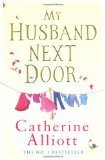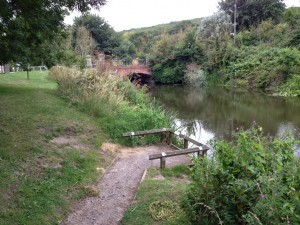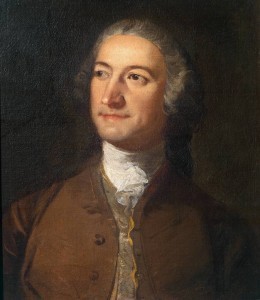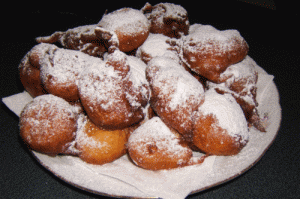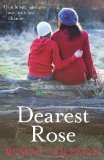Hannah Fielding's Blog, page 122
September 20, 2013
Book review: My Husband Next Door by Catherine Alliott
From the blurb:
When Ella married the handsome, celebrated artist Sebastian Montclair at just nineteen she was madly in love. Now, those blissful years of marriage have turned into the very definition of an unconventional set-up. Separated in every way but distance, Sebastian resides in an outhouse across the lawn from Ella’s ramshackle farmhouse.
With an ex-husband living under her nose and a home crowded by hostile teenaged children, gender-confused chickens – not to mention her hyper critical mother whose own marriage slips spectacularly off the rails – Ella finds comfort in the company of the very charming gardener, Ludo. Then out of the blue Sebastian decides to move on, catching Ella horribly unawares. How much longer can she hide from what really destroyed her marriage . . . and the secret she continues to keep?
When I’m in the mood for a light, witty romance in the women’s fiction genre (dare I call it chicklit?), I have long enjoyed a Catherine Alliott. Her style is warm and funny, and I love her characterisation. So I was keen to read this, her latest novel.
As always, I loved the writing style in the book. So much to make you smile; she’s a wonderfully observant writer, and I enjoyed the conversational tone in the book. It’s easy reading, and when I pick up a book like this, that’s exactly what I’m looking for.
The story was certainly engaging – and unusual, because the husband is lurking at the periphery throughout the book. I really loved the content on Ella and her husband’s art, and how central this becomes to the story: as a writer, I found the vein of art running through the book, and the exploration of how being creative affects a relationship, fascinating. I especially enjoyed the description of Ella and Sebastian’s early, somewhat bohemian relationship.
The setting, on a ramshackle farm, is perfect for the book, and for any reader who enjoys stories set in rural settings where you’d best check there’s no chicken roosting on a chair before sitting down. Even though the book is set in the countryside, it reminded me of light romances whose protagonists are struggling among the yummy mummy set in the suburbs – such as the local ladies who are pedantic about how exactly to arrange flowers in the local church.
Ella is interesting as a main character, though for me she’s not always easy to root for. She’s up against it, that’s certain, but as she discovers herself during the course of the book, she’s become something of a ghost without a lot of gumption and passion. She lets her children walk over her. She lets her husband walk all over her. She lets her mother move to her farm, though she doesn’t want her to. She does a job she doesn’t enjoy while ignoring what she really wants to do. She’s passive, and I found myself thinking often, ‘Come on, Ella. Get some steel!’ The ending goes some way to remedy this, and I loved the twist.
Overall, this is a book to pick up for sheer escapism, for those who like a story in which a character goes on an emotional journey and blossoms, and for those who like a more unconventional love story. But don’t expect high romance – lots of passion and moments that make you sigh. It’s more of a family story, I think, than pure romance.
My Husband Next Door is available now from Amazon; click on the book cover below to visit the store.
September 19, 2013
Bridge over peaceful water
September 17, 2013
Favourite artist: Francesco Zuccarelli
While researching my latest novel The Echoes of Love, which is set in Venice and Tuscany, Italy, I read widely on the country – cuisine, architecture and, of course, art. One of the artists whose work most appealed to me was Francesco Zuccarelli, and so I weaved into the story one of his paintings, which I placed in my heroine Venetia’s apartment.
Zuccarelli was a highly acclaimed painter of the late Baroque period. Baroque art originated in Rome before spreading across Europe – deeply admired by the Roman Catholic Church and the aristocrats of most countries. The Baroque style was highly dramatic (think exaggerated poses), making it very easy to interpret by the viewer. It celebrated drama and passion and grandeur, and was not limited only to painting, but also extended into literature, sculpture, dance, music and architecture.
Zuccarelli was born in 1702 in Tuscany. At the tender age of 11, he began an apprenticeship with a portrait painter named Giovanni Maria Morandi. Zuccarelli remained in Tuscany until he was 30 years of age, during which time he honed his craft in painting and etching, focusing on religious and mythological scenes, and he developed an interest in landscape drawings.
Venice was (and is) the perfect setting for any landscape artist, and in 1732 Zuccarelli moved here. The death of artist Marco Ricci had created something of a gap in the market for a landscape artist, and Zuccarelli was quick to fill it – to good appreciation, for people loved his style, especially the kind colours he used and his trademark soft, sweet expressions on figures. Soon he was enjoying the patronage of powerful personalities. He also began collaborating with others, notably with celebrated architect and artist Antonio Visentini, with whom he produced a set of playing cards themed on the Old Testament.
Other notable works from Zuccarelli at this time include a set of dreamy paintings based on the Bible story of Jacob which now hang at Windsor Castle, England. Indeed, he travelled to England in 1752, where he was inspired to paint a Macbeth scene. Subsequently, King George III snapped up no less than 25 of his works at auction. The English loved his style, and when he returned to England in 1765 he was much in demand. He was even a founding member of the British Royal Academy of Arts, and he was personally commissioned by the king for a work (Finding of Moses).
Back in Venice, Zuccarelli was invited to join the prestigious Venetian Academy, for both critics and the establishment alike loved his works. He rose through the ranks to become president, and continued to paint until his death in 1788 in Florence.
For me, Zuccarelli represents just one of so many fascinating elements of Italian culture. It is easy to see why I chose to situate my love story in Venice and Tuscany, amid such a rich artistic and intellectual heritage, given that my heroine is a mosaic restoration specialist.
If you’d like to see Zuccarelli paintings, the BBC Arts website offers a slideshow of 57 of his works here: www.bbc.co.uk/arts/yourpaintings/artists/franco-zuccarelli. You can also watch a video of some of his works here: www.youtube.com/watch?v=WDxu4xdgZ8Q.
September 16, 2013
Sunset on Summer Fun: Win a Nook/Kindle and my book
I’m delighted to be sponsoring the btsemag.com Sunset on Summer Fun blog hop.
My Giveaway
My offering is a paperback copy of my novel, Burning Embers.
To win, simply:
Comment on this blog post by the end of 30 September
Telling me what most most fun for you this summer
Being sure to include your name and a contact email
INT entries welcome.
The Big Giveaway
To win a Kindle or Nook, go to http://btsemag.com/contests/blog-hops-join/ and use the Rafflecopter form.
Hop Along to the Next Blog
[image error]
Sponsors:
September 15, 2013
Recipe: Traditional Venetian frittelle doughnuts
One of my favourite things about Italy is the cuisine. So many delectable delights to savour! When I visited Venice, I liked nothing better than to settle in one of the thriving pavement cafes and sample the sweet treats alongside some of the rich, aromatic coffee on offer. That is how I came to try fritelli veneziane.
These little doughnuts are bite-sized pieces of heaven – utterly decadent, but delicious and morish. They’re famous in Venice, and date back hundreds of years; indeed, in the eighth century they were the national cake of the Venetian state. They’re very popular at Carnival time.
I loved them so much when I tried them that subsequently I wrote them into my novel The Echoes of Love, creating the coffee shop Fritelli where my heroine Venetia goes often with her friend Francesca to talk and watch the world go by and have a little treat.
Today I’m sharing with you a simple recipe you can use to make these little naughty-but-nice morsels at home. It may not be the original eighth-century recipe, but it’s pretty delicious all the same!
Ingredients
100g caster sugar
2 tablespoons brandy or rum
250ml milk
25g yeast
3 eggs
300g all-purpose flour
30g pine nuts
50g butter
70g raisins
icing sugar, to dust
oil for frying (peanut or pine nut)
Pinch of salt
Zest of 1 lemon
Wash and dry the raisins. Soak overnight in the rum or brandy.
Warm the milk a little and stir in the yeast until dissolved.
Melt the butter.
Place half the sugar in a bowl and mix in the eggs, then add the butter, milk-and-yeast, raisins, pine nuts and lemon zest and bring together into a smooth dough.
Add the flour and salt, bit by bit, and knead thoroughly.
Leave the dough to rise for an hour (should be double in size).
Heat the oil to a high temperature, and drop balls of dough in. Fry until golden.
Dry on paper towels and sprinkle with sugar. Serve warm or cold.
If you’re feeling especially decadent, you can pipe cream or chocolate sauce into the centre of each.
September 13, 2013
Book review: Dearest Rose by Rowan Coleman
From the blurb:
‘You are a remarkable woman and you deserve all the happiness, contentment and love in the world. I, for one, know that I have never met anyone quite like you.’
When Rose Pritchard turns up on the doorstep of a Cumbrian B&B it is her last resort. She and her seven-year-old daughter Maddie have left everything behind. And they have come to the village of Millthwaite in search of the person who once offered Rose hope.
Almost immediately Rose wonders if she’s made a terrible mistake – if she’s chasing a dream – but she knows in her heart that she cannot go back. She’s been given a second chance – at life, and love – but will she have the courage to take it?
Dearest Rose is a touching, sentimental, captivating story about lost family, lost time, forgiveness, love and new beginnings. Brimming with strong female characters, it slowly builds up the back story of Rose, the main character, whilst describing the awful situation in which she suddenly finds herself and her young daughter late one night. Rowan Coleman deals sensitively with emotional and often taboo subjects in her writing of this novel, providing an at times harrowing rollercoaster of a journey for many of the characters and the reader, but still giving amazing depth and dignity to the characters involved. It had me hooked very quickly and the trickling of new background information on Rose’s past ensured that I continued to be hooked throughout the book.
Rose arrives in a new town with her seven-year-old daughter in the middle of the night and knocks on the door of the B&B as she looks desperately for somewhere to stay. They have brought very little with them, just a package wrapped in a blanket and a few items of underwear, hastily grabbed as they made their quick escape from their home. Rose has left her long-term husband after years of emotional abuse. She has come to the town to get as far away as possible, to start a new life and to close the door on her past. She has come to this town in particular because of a chance one-hour meeting with a total stranger several years before.
How different would she, her life, have been if she’d met a man with whom she could simply laugh, whose eyes she could look into without hesitation, a man who’d made her feel … simply normal?
Yet Rose soon finds out that there is more than just this stranger pulling her towards this town.
‘… That’s fate, that is. That is God telling you something.’
‘Fate.’ Rose repeated the word slowly. ‘Fate makes it sound like you have no choice about what happens to you, but I don’t think that’s true. I think if I left everything up to fate then I wouldn’t be here. It was going against fate that brought me here.’
Indeed, it does seem that fate has led Rose to this town, where she finds not just her stranger, but also another significant man from her past. Can she reconcile these aspects of her past with her new life, and is she strong enough to keep away from her abusive husband?
There are some wonderful characters in this book – from a bolshie best friend, a say-it-as-you-see-it landlady, a grumpy old man and, my favourite, an honest, scared little girl – Rose’s daughter, Maddie – who has the characteristics of honesty and speaking her mind.
‘But why?’ Maddie sighed unhappily. ‘I don’t like school. Teachers don’t like me, children don’t like me and I don’t like them. I’m not the sort of child who suits school. You could keep me at home and let me be a genius.’
There are also some lovely descriptions of the scenery of the Lake District where it is set, and of art and painting. And the most important theme for me is of second chances, because many of the characters in the book need them at different stages of the story, and for the most part people deserve them, even in real life.
Overall, this book was a charming read, despite its heavy topics, leading to a romantic and happy ending – a must for all lovers of romance fiction.
Dearest Rose is available now from Amazon; click on the book cover below to visit the store.
September 12, 2013
Fall into Romance Blog Hop: My recommended autumn read
Today I’m delighted to be participating in the Fall into Romance Blog Hop. I’ve chosen one of my favourite recent romantic reads that’s sure to cheer and warm you up as the cold creeps along and the nights draw in.
Since You’ve Been Gone by Anouska Knight
 In one tragic moment, Holly Jefferson’s life as she knew it changed for ever. Now to the external world, at least she’s finally getting back on her feet, running her business, Cake. Then she meets Ciaran Argyll.
In one tragic moment, Holly Jefferson’s life as she knew it changed for ever. Now to the external world, at least she’s finally getting back on her feet, running her business, Cake. Then she meets Ciaran Argyll.
His charmed life feels a million miles from her own. However, there’s more to Ciaran than the superficial world that surrounds him, and he too is wrestling with his own ghosts.
Will Holly find the missing ingredient that allows her to live again and embrace an unknown and unexpected tomorrow?
How do you learn to love again?
I was eager to read this book, given that it won Mills & Boon’s and ITV Lorraine’s search for the next big thing in contemporary women’s fiction. What a deserved winner! I loved the book. Loved it. It’s warm, it’s powerful, it’s poignant and its steeped with romance. Ciaran makes for a very attractive male lead, and Holly is so easy to like. As the two characters ‘wrestle with their ghosts’ I found myself so invested with their story and hoping at every turn that they would find a way to let go of the past and be together.
I love the author’s descriptive writing, which really sets the scene. For example:
Gnats drifted on the same warm summer breeze that saw colourful paper lanterns swaying on the their strings. Lily of the valley filled jam jars at each table, but sweet peas had won out in the battle to fragrance the evening air.
So wonderfully evocative!
I also like the messages that come through in the book about love and loss, and the very sensitive and intelligent exploration of grief. When you loved someone and lost him tragically, how do you let yourself love again? The author is expert at moving the reader between light and dark, so that by the end of the book you feel that you’ve been on a cathartic journey.
For me, the vein of warm humour running through the book really adds to the appeal. And the author even manages to blend moments that make you smile with moments that make you fan yourself – especially in one very memorable and colourful intimate encounter (I won’t spoil it for you be explaining, but trust me, you’ll love that scene!).
Overall, I think Anouska Knight has a long career ahead of her as a romance novelist. I, for one, will be keen to pick up her next novel, safe in the knowledge that it will sweep me away and make me fall in love with the characters.
Now for the fun bit! For the hop, I’m giving away another romance novel that’s sure to kindle your flames this autumn: my novel, Burning Embers, set in sultry Kenya. I have two copies up for grabs. To win, simply:
Comment on this page telling me what you love best about autumn
Between 13 and 21 September
Making sure you give your name and a contact email
Good luck! And now click on the Hop button below to visit the next blog in the hop.
‘My love is like a red red rose’
September 10, 2013
The gondola: Quintessential Venice
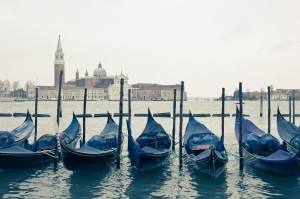 Sylvia Pankhurst wrote: ‘Venice is a wondrous city of fairest carving, reflected in gleaming waters swirled to new patterning by every passing gondola’… a perfect description that entirely matches my own impression of the city. And who can think of Venice without at once conjuring up a mental picture of the romantic and historic boat used to traverse its many waterways – the gondola?
Sylvia Pankhurst wrote: ‘Venice is a wondrous city of fairest carving, reflected in gleaming waters swirled to new patterning by every passing gondola’… a perfect description that entirely matches my own impression of the city. And who can think of Venice without at once conjuring up a mental picture of the romantic and historic boat used to traverse its many waterways – the gondola?
In my new book, The Echoes of Love, the gondola is an integral part of the cityscape, a often-present background element that speaks of the unique Venetian setting. But of course, no romance set in Venice would be complete without gliding along the canal on one of the famous crafts, and so my characters Venetia and Paulo take a lazy, evening gondola ride to a restaurant – the perfect pre-dinner romantic interlude.
No doubt you are familiar with the gondola, if not through your own travels then through its appearance in books and films and travelogues. But in my research for The Echoes of Love I uncovered some interesting facts that you may not be aware of – so today I’m sharing them with you.
1. Once, the gondola was the primary means of transportation in the city of Venice, with around 10,000 in operation in the 17th and 18th centuries, but today it’s primarily tourists and lovers who take the 400 remaining crafts, especially to cross the wide Grand Canal, and they also feature extensively in the Venice Annual Regatta.
2. Many people assume that gondolas are punted along, but in fact the waterways of Venice are too deep for punting and so the gondolier uses an oar, not a punt, and rows with forward and back strokes.
3. Historically, gondolas had a small cabin, called a ‘felze’, to afford privacy and shelter. The cabin could be rendered entirely private by closing the blinds (the first Venetian blinds), and hence the boat rides gained a reputation for affording intimacy.
4. Venetian law demands that all gondolas be painted black.
5. Since the mid-20th century, no adaptations have been permitted to the design of the gondola. The design is uniform: they weigh 1,500 pounds; have 280 components; are made from lime, larch, oak, fir, cherry, walnut, elm and mahogany; and are 10.87 metres long and 1.42 metres wide.
6. The Venetians are very proud of their gondola heritage, and have set up an Institute for the Protection and Conservation of Gondolas and Gondoliers.
7. The fèrro (meaning iron) at the front of the boat is not just adornment, but serves the practical purpose of counterweighing the gondolier standing at the back.
8. The first reference to a gondola appeared in 1094. No one knows from where the name originates, but some say it is from the Greek for cup or mussel.
9. Gondoliers are licensed professionals who must undertake training and sit an exam covering practical skills, Venetian history and landmarks, and foreign language skills.
10. The first female gondolier was accepted in 2010; before this time, the profession of gondolier was entirely male-centric.
September 8, 2013
The allure of mystery in romance
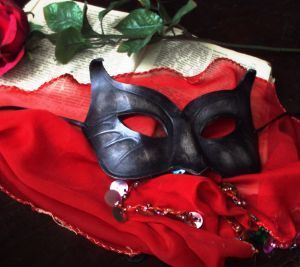 I confess I have always been a fan of mystery. I love to curl up on a wintry day with a good mystery novel, full of twists and turns that keep me on my toes. And when I came to write my first novel, Burning Embers, I quickly realised that I found mystery to be an integral part of a romance novel as well.
I confess I have always been a fan of mystery. I love to curl up on a wintry day with a good mystery novel, full of twists and turns that keep me on my toes. And when I came to write my first novel, Burning Embers, I quickly realised that I found mystery to be an integral part of a romance novel as well.
Most novels contain some degree of mystery. Mystery and intrigue are what keep readers turning pages, eager to knit together the clues into a cohesive, satisfying whole at the end. If an author delivered the entire story in the first chapter, what point would there be in reading on?
But apart from the drive to include mystery as an integral part of fiction, the romance author has an added impetus: mystery heightens romance.
Imagine the heroine meets an attractive man. He invites her for a drink, and they sit together in a pavement café, watching the world go by, glancing coyly at each other and getting to know one another. Sounds like a perfect start to romance. But that is assuming that the ‘getting to know one another’ element contains that essential ingredient: mystery.
By the end of the date, each person does not know all there is to know about the other. A man or woman who lays bare his or her entire inner world – their past, their future dreams; their mistakes, their successes; their weaknesses, their strengths; their hopes, their fears – to a virtual stranger would not be considered romantic, but lacking in boundaries and, possibly, a little odd!
No, instead by the end of the first date each person has only:
Light, superficial knowledge of the other: name, occupation, area of dwelling, favourite food, favourite poet and so on.
An inkling of what runs deeper beneath the surface: an idea of character and aspirations that forms the basis for attraction, passion and a blossoming relationship.
But beyond this initial impression, there is much to be discovered. And, indeed, both parties usually harbour secrets of some sort whose eventual honest sharing will lay the foundations for a relationship built on openness and trust.
In Burning Embers, for example, Coral and Rafe first meet upon a boat bound for Mombasa, Kenya. Coral is returning to the land of her birth to take up an inheritance, and Rafe appears to be nothing more than a gallant gentleman who, having found Coral alone and tearful on the deck, offers ‘the comfort of strangers’. In fact, the reader soon discovers this handsome is no stranger, but a man tied closely to Coral’s fate. But not until the end of the book does Coral get to the very heart of the mysterious shadow that haunts Rafe’s heart. In this, the beginning of their love, the mystery serves to fuel the fire that has ignited in Coral:
They stood close to each other, almost touching. His hand reached out and, with infinite tenderness, covered the slender fingers clenching the rail. A pleasant warmth flooded her. She was afraid to move in case she disturbed that initial, yet powerful, contact. For a fleeting moment, in this wan light and because he spoke gently, her wounded heart yielded to this stranger’s soothing voice.
As poet John Donne wrote in ‘The Ecstasy’, ‘Love’s mysteries in souls do grow.’ It is not about playing games – of a woman being deliberately over-coy or a man willfully concealing what his lover should know of him. Instead, it is a case of respecting the slow unfolding of a relationship, the magic of the mystery, and the importance of a gentle stoking to fuel burning embers into passionate, lasting flames.

